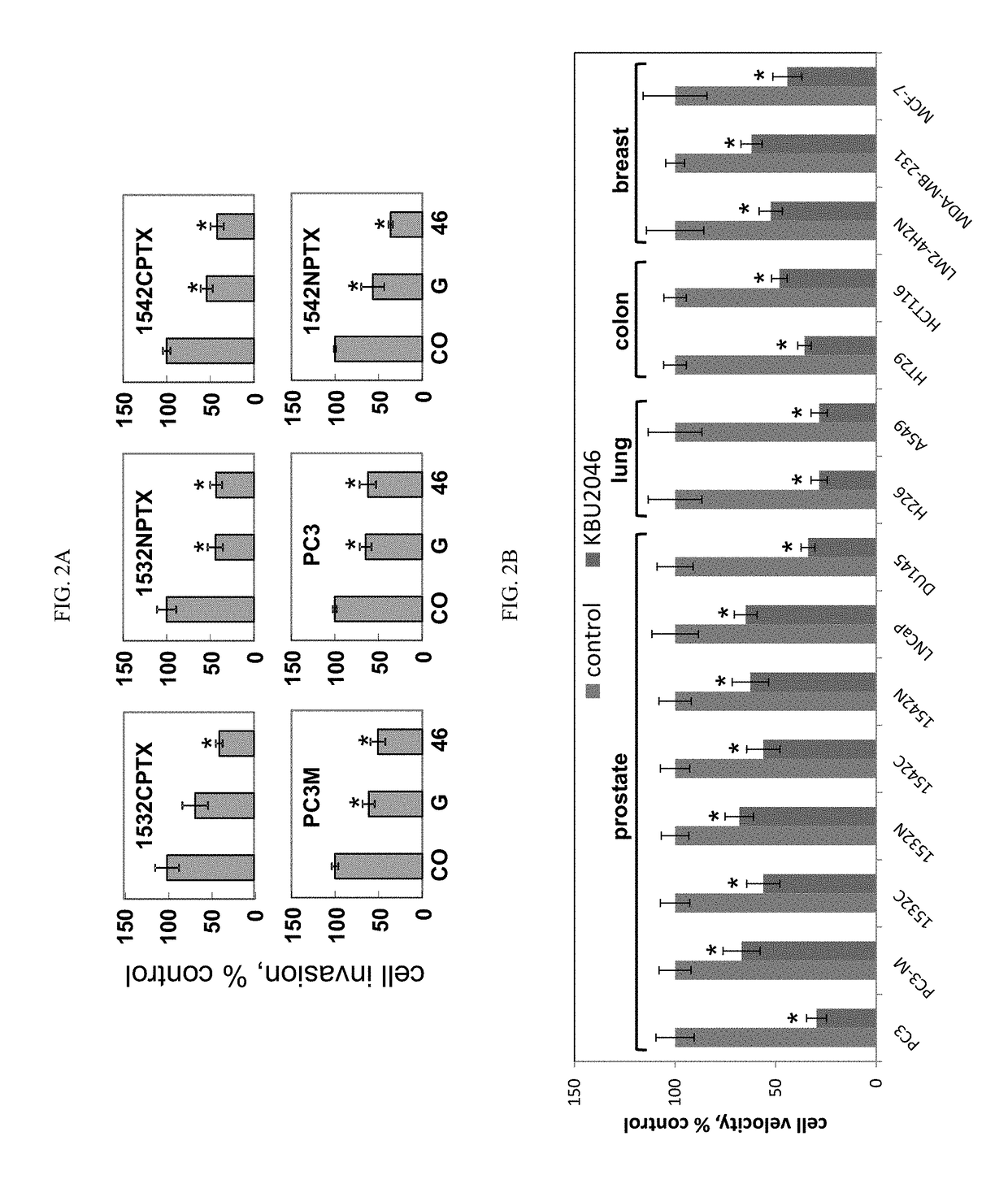Inhibition of cancer cell motility
a cancer cell and motility technology, applied in the direction of respiratory disorder, sexual disorder, drug composition, etc., can solve the problems of cancer-related mortality and the majority of cancers, and achieve the effects of overcoming hormone resistance, preventing cancer cell movement, and improving the effectiveness of hormone therapy
- Summary
- Abstract
- Description
- Claims
- Application Information
AI Technical Summary
Benefits of technology
Problems solved by technology
Method used
Image
Examples
example 1
Materials and Methods
Selection and Synthesis of Optimized Small Chemical Probes
[0124]Functional screens consisted of a Boyden chamber cell invasion assay (Craft et al., 2007; herein incorporated by reference in its entirety) for efficacy, and a three day cell growth inhibition assay (Liu et al., 2002; herein incorporated by reference in its entirety) for toxicity. Additional functional measures of toxicity included a NCI-based screen of the NCI 60-cell line panel (Shoemaker, 2006; herein incorporated by reference in its entirety), expression of estrogen-responsive genes by qRT / PCR (Ding et al., 2007; herein incorporated by reference in its entirety), induction of an estrogen-responsive promoter by luciferase assay (Breen et al., 2013; Catherino and Jordan, 1995; herein incorporated by reference in their entireties), and a hematopoietic stem cell 14-day colony formation assay (Bergan et al., 1996; herein incorporated by reference in its entirety). Protein Data Base (PDB) X-ray crysta...
example 2
Exemplary Procedure for Large-Scale Production of 4′-Fluoroisoflavanone (KBU2046).
[0129]
3-(dimethylamino)-1-(2-hydroxyphenyl)prop-2-en-1-one. The starting materials 2′-hydroxyacetophenone (50 mmol, 6.02 mL) and N,Ndimethylformamide dimethyl acetal (50 mmol, 6.64 mL) were added to a 10-20 mL microwave vial. The vial was capped and heated in a Biotage Initiator microwave synthesizer at 150° C. and 11 bar for 10 minutes. The resulting dark orange liquid was allowed to cool to 23° C., at which time yellow-orange crystals crashed out of solution. The crystals were collected and washed with hexanes (50 mL), then dried and weighed to give 3-(dimethylamino)-I-(2-hydroxyphenyl)prop-2-en-I-one (9.09 g, 95%) as orange-yellow needles. Product was confirmed by NMR and ultra-performance liquid chromatography / mass spectrometry (UPLCMS).
[0130]
3-bromochromone. 3-bromochromone was prepared by a procedure taken from Gammill (Gammill, 1979; herein incorporated by reference in its enti...
example 3
KBU2046 Inhibition of Cell Motility and Metastasis
Identification of a Selective Inhibitor of Cell Motility and Metastasis
[0135]Flavonoids were selected as a platform to advance the synthesis of probes, for at least the reasons that they exert a wide range of biological effects, and because changes in their structure by a single atom can significantly impact their spectrum of biological activity (Andersen and Markham, 2006; herein incorporated by reference in its entirety). Consequently, they constitute biological probes with atom-level resolving capacity, and their chemical scaffold supports a high level of tailored, selective, medicinal chemistry refinement. 4′,5,7-trihydroxyisoflavone (genistein) was selected as a starting point. It has been demonstrated that genistein inhibits human prostate cancer (PCa) cell invasion in vitro (Huang et al., 2005; herein incorporated by reference in its entirety), and in the context of a prospective human trial that it down regulates matrix metal...
PUM
| Property | Measurement | Unit |
|---|---|---|
| body weight | aaaaa | aaaaa |
| body weight | aaaaa | aaaaa |
| body weight | aaaaa | aaaaa |
Abstract
Description
Claims
Application Information
 Login to View More
Login to View More - R&D
- Intellectual Property
- Life Sciences
- Materials
- Tech Scout
- Unparalleled Data Quality
- Higher Quality Content
- 60% Fewer Hallucinations
Browse by: Latest US Patents, China's latest patents, Technical Efficacy Thesaurus, Application Domain, Technology Topic, Popular Technical Reports.
© 2025 PatSnap. All rights reserved.Legal|Privacy policy|Modern Slavery Act Transparency Statement|Sitemap|About US| Contact US: help@patsnap.com



